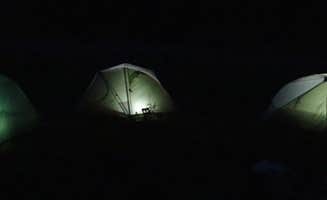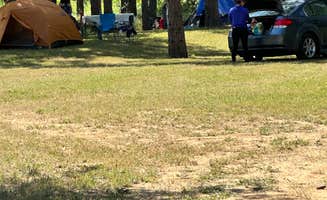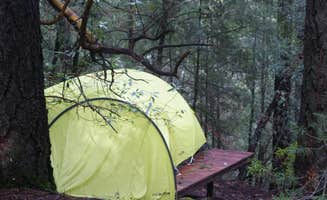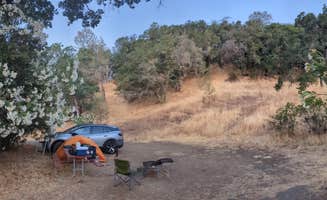Tent camping near Colusa, California offers options in diverse terrain ranging from 1,000 to 7,000 feet elevation. Most campgrounds in this region experience seasonal fire restrictions during summer months when temperatures frequently exceed 90°F. Water availability varies significantly between locations, with many primitive sites requiring campers to bring their own supply or filter from natural sources.
What to do
Hiking opportunities: At Snow Mountain Wilderness, trails lead to backcountry campsites along Cache Creek. "If flow allows you can continue on after fording the creek into the Cache Creek Wilderness are where there is a resident herd of elk," notes one visitor who spotted eagles in the canyon.
Water recreation: Steele Canyon at Lake Berryessa provides calm waters ideal for paddleboarding. "I came to check out the more calm waters in the canyon for my paddleboard. The site was great layout and I had a really enjoyable time out on the water. Other boaters where very respectful of the no wake zones," reports one camper.
Mountain biking: Boggs Mountain Demo Forest features newly constructed trails through recovering forest terrain. A visitor mentioned, "I still come here to enjoy the new growth, the impressive new trails and the new views of the valleys below," adding that despite post-fire conditions, the $25 nightly fee remains worthwhile.
Wildlife viewing: Eagle sightings are common in Snow Mountain Wilderness canyons, with multiple visitors reporting consistent sightings. The resident elk herd in Cache Creek Wilderness provides another wildlife viewing opportunity during spring and early summer months when animals are most active.
What campers like
Privacy and solitude: Campsites in the 50s and 80s at Manzanita Canyon offer more secluded tent camping. "Gorgeous views, room for multiple tents, but no shade and difficult access to rocky waterfront," notes a camper who appreciated the isolation despite challenging terrain access.
Off-season camping: Camp Far West North Shore transforms during winter months. One camper described their experience: "We were the only people anywhere except for folks in the full hook-up area, which was far from us. We were right on the lake at the end of a peninsula. Not a sound except for the birds."
Night sounds: Several campgrounds offer distinctive nighttime experiences. "Fish splash cows moo, and great lake views," wrote one camper about Lake Berryessa, mentioning "The stargazing is great and there's a periodical splash of a fish from the lake."
Clean facilities: Many tent sites maintain basic but well-kept amenities. As one visitor to Bear Creek Campground simply stated, "Found a great spot. Nice view and campsite. Clean."
What you should know
Limited water access: Most primitive tent sites require bringing your own water supply. At Camp Far West North Shore, a visitor noted, "The fire pits and bbqs are non functioning, we had to build our own fire ring. And the broken glass....... man it was everywhere!"
Fire restrictions: Summer camping often comes with complete fire bans. At Steele Canyon, a camper reported: "It's dry camping at this time (no fires, no water, no hookups, etc.). Fire scars all around the lake...looks like this entire area got hit a few years ago."
Temperature fluctuations: Despite warm days, nights can be surprisingly cold. One camper at Lake Berryessa shared, "It got really cold at night (32 degrees), but my fault for not checking the weather."
Cell service: Connectivity varies by location. Lower Hunting Creek offers "Decent Verizon signal" according to one camper, while Steele Canyon reportedly provides "Full bars on Verizon service!"
Tips for camping with families
Best tent camping for kids: Lake Berryessa offers family-friendly swimming areas. "Our favorite spot to take the kids to the lake. If your looking for something calm this is the spot at Lake Berryessa," recommends one parent who frequents the area with children.
Safety considerations: Some sites require extra precautions with children. "The campsites on the bluff of the hill can get windy so be prepared for that," advises a camper at Steele Canyon, pointing out a potential hazard for families with small children or lightweight equipment.
Glamping options: For families seeking more comfort, Pine Grove Cobb Resort offers furnished tents with nearby facilities. "Four of us stayed in the Glamping Tent for two nights and it was perfect- very comfortable and relaxing. We also had access to our own private bathroom and shower a short walk away," reports one group.
Activity planning: College football games can be streamed at Boggs Mountain Demo Forest for families wanting entertainment options. "College football streaming and beer drinking after mountain biking?" noted one camper who appreciated maintaining some modern comforts while camping.
Tips from RVers
RV fees: Camp Far West North Shore charges additional vehicle fees. "Pricing for camping is a bit steep if you plan to bring more than 1 vehicle," warns one RVer who visited with family.
Seasonal considerations: Staff availability varies throughout the year at these campgrounds. One RVer at Steele Canyon noted, "I got there after they closed (closes at 5pm.) But there's a number to call that was posted for after hours. A camper in front of me had already called and someone arrived within minutes."







